Intro: Dominating the Waiver Wire Allows You To Never Give Up
In fantasy football, we typically put 99% of our focus into the draft. And I understand why. Drafting is the most fun part of fantasy football. It’s the one time of year when you get together with your friends and family and hand-select the best players that will lead your team to fantasy glory in December. There’s no better feeling than refreshing your team page on ESPN or Yahoo after the draft and marveling at the abundance of projected points that fill out your starting lineup.
However, once the NFL season starts, reality comes crashing in and shatters your perfectly constructed draft. In Week 2, your first-round RB tears their ACL. A few weeks later, your second-round WR steps away from the NFL for mental health reasons, never to return. Chaos strikes, and it is easy to panic. Or worse — give up completely. All of a sudden, when 50% of your roster consists of players you didn’t even draft, that August Sunday during draft season no longer feels as important.
In 2023, I am joining the Establish the Run team to help you dominate the waiver wire, which is, in my opinion, the most important lever experienced fantasy players have to consistently dominate their home leagues.
For each week of the NFL season, I’ll write an article and host a live YouTube show to help ETR subscribers identify the best waiver wire pickups, and provide guidance on how to use your FAAB dollars or waiver claims to execute your strategy.
Before we get to the in-season content, however, I wanted to cover two topics to help you approach the waiver wire from a macro lens, before we get into the micro-level player takes and recommendations in-season. These topics are:
The Historical Waiver Wire Analysis will be more of a quantitative, data-backed analysis of what’s available on the waiver wire in a typical season, using historical fantasy-scoring and ADP data dating back to 2016. This will help ETR subscribers understand:
- What archetypes of players we should target on the waiver wire, and how that varies by position
- What FLEX position (RB vs. WR) typically has more startable production available on the waiver wire
- What FLEX position (RB vs. WR) typically has more star power available on the waiver wire
- The viability of streaming QBs off the waiver wire, as fantasy scoring at the position becomes more predictable
The Top Five Waiver Wire Tips section provides more feel-based guidance on how to approach the waiver wire based on my decades of experience playing fantasy football across a range of platforms and formats.
Historical Waiver Wire Analysis
Methodology
The following analysis assumes the following league settings, intended to match your average home league that you play with friends, family, enemies, and/or co-workers:
- PPR scoring
- 1 QB / 2 RB / 2 WR / 1 TE / 2 FLEX / 5 BENCH / 1 K / 1 D/ST
ADP data is from fantasydata.com, which uses an aggregate of different sources throughout the industry.
Historical Waiver Wire Studs
I defined “Waiver Wire Studs” as players that go undrafted in most fantasy leagues, yet emerge as bonafide fantasy studs at their positions: top-12 RBs, top-12 WRs, top-six QBs, or top-six TEs by PPR points per game. Since 2016, there have been 14 such players:
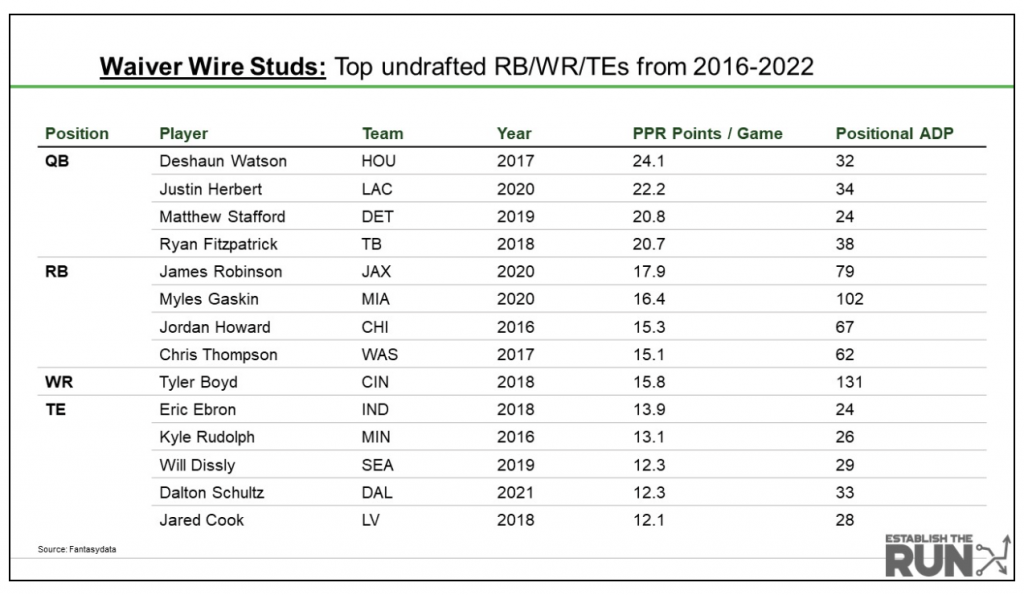
Key Takeaways
- Historically, it has been much easier to find studs at QB, RB, and TE compared to WR. Tyler Boyd’s Year 3 breakout (after a disappointing Year 2) is the lone example of a Waiver Wire Stud at WR, with 4+ examples at QB, RB, and TE. This bolsters arguments of drafters who advocate for drafting WRs in the early rounds, noting that it is much easier to find waiver wire breakouts at the other positions compared to WR.
- Rookie QBs offer your best chance at a stud QB, with both Deshaun Watson and Justin Herbert’s rookie campaigns offering high-end QB1 outcomes. Cam Newton, though outside of the scope of this data set, was also the QB3 overall with 23 points per game as a rookie. Though rookie QBs can have dangerously low floors (explaining drafters’ current disinterest in the likes of Bryce Young and C.J. Stroud), it is worth taking chances on rookies that flash a fantasy ceiling early in the season.
- At RB, target uncertain backfields aggressively early in the season. James Robinson (Jacksonville), Myles Gaskin (Miami), and Jordan Howard (Chicago) emerged out of nowhere as Week 1 starters, while the market projected volume onto their relatively unheralded backfield mates. This year, I would be looking to make aggressive moves on the waiver wire in uncertain backfields (mainly: New Orleans, Miami, Philadelphia, Tampa Bay, and Chicago) if Week 1 shows an unexpected starter taking the reins.
- At TE, it’s relatively common to find studs off the wire, but note that none of these TEs have been truly “game-breaking” TEs. Eric Ebron was the TE4 with 13.9 points per game in 2018, but his scoring was closer to the TE12 that year (Kyle Rudolph) than the TE1 (Travis Kelce, 18.4 PPG).
Historical Waiver Wire Starters
“Waiver Wire Starters” are defined similarly to studs, but they have to meet a lower threshold for production: top-24 RB/WRs and top-12 QB/TEs by PPR points per game. There have been 55 such players since 2016: 10 QBs, 11 RBs, 13 WRs, and 21 TEs.
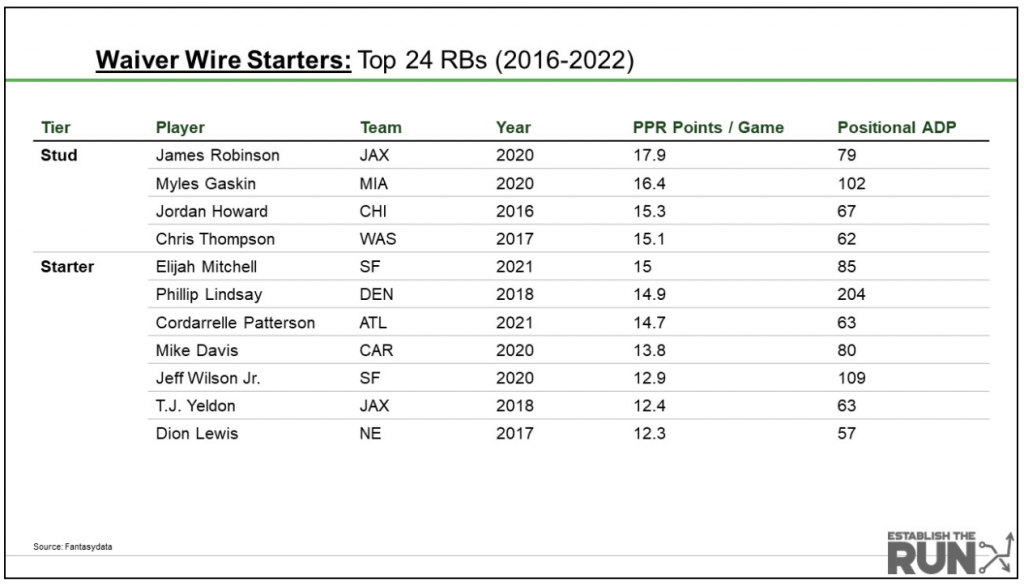
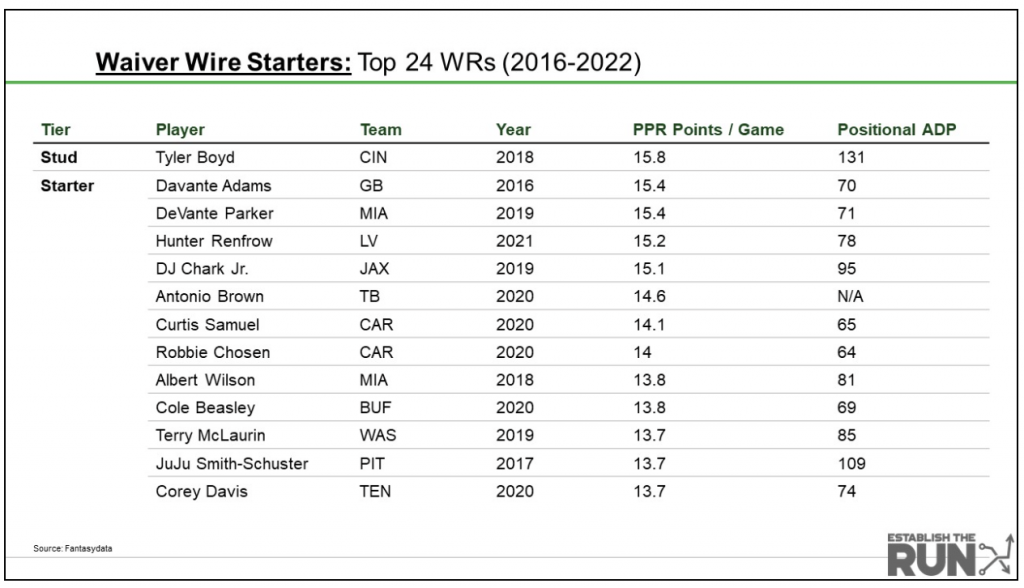
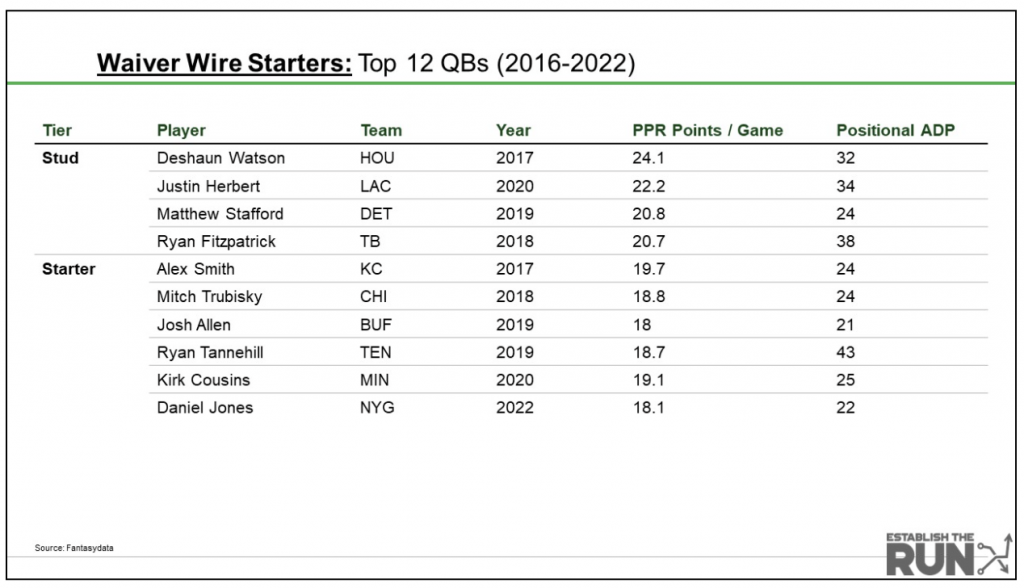
Key Takeaways
- While we learned that finding Waiver Wire Studs at WR is extremely rare, it is much easier to find starters. Contrary to public opinion, it has actually been easier to find starting-level WRs off the wire compared to RB since 2016.
- Finding Waiver Wire Starters at TE is extremely common. Since 2016, there have been, on average, three TE starters available on the wire per year. This speaks to the binary nature of the TE position, where it is often best to target either an elite TE or wait until the end of your draft to take a few fliers and play the waiver wire game at the position.
Historical Waiver Wire Flexes
Again, “Waiver Wire Flexes” are defined similarly to starters/studs, but they have to meet a lower threshold for production. Flexes (at RB/WR/TE only) have to meet a per-week scoring threshold that would make them flex-worthy starters (assuming 2 RB, 2 WR, 1 TE, 2 FLEX starting lineups). Since 2016, there have been 100 such players: 24 RBs, 58 WRs, and 18 TEs.
Key Takeaways
- Finding flex-worthy WRs off the wire in PPR leagues is quite easy to do. Since 2018, there have been ~8 flex WRs per season, compared to just ~3 flex RBs.
- You may be wondering why there are fewer flex TEs than starter TEs. This is because the scoring threshold to become a top-12 TE is actually lower than the scoring threshold to be a flex-viable starter, where TEs are competing against RB/WRs. This speaks to the overall low-scoring nature of the TE position, and why it’s usually not optimal to try to fill the flex with a TE.
Summary of Studs, Starters, and Flexes by Position
Let’s look holistically at the number of studs, starters, and flexes available at each position since 2016.
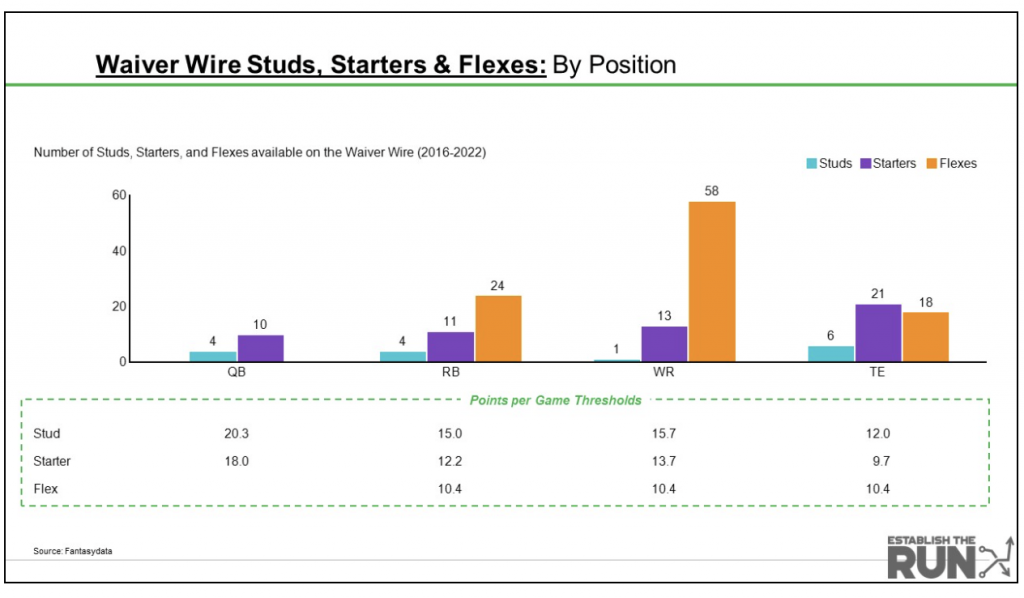
Key Takeaways
- To reiterate, it’s likely impossible to find studs at WR off the waiver wire, but it is relatively easy to find starters (~2 per year) and flexes (~8 per year).
- On the flip side, finding studs at RB is more common than at WR, though it is more challenging to find starters (~1.5 per year) and flexes (~3 per year).
- TE is the easiest position to find studs and starters off the waiver wire, suggesting a “boom-or-bust” approach in managed home leagues is likely optimal. That is, either target the elite tier of TEs like Travis Kelce and Mark Andrews, or wait until the end of your drafts to take a flier and leverage the waiver wire if that pick fails.
- The data suggests QB is the most challenging position to find difference-making starters off the waiver wire. This suggests that streaming QB off the waiver wire is less viable than it used to be in home leagues, as the QB position gets more predictable and the market gets better at pricing in rushing upside for QBs. That said, in 1-QB leagues, there will always be at least some QBs that are NFL starters on waivers, meaning you can find some floor weeks off the wire in a pinch.
Fantasy Football as a Weekly Game
Seasoned fantasy football veterans may point out that while we have been looking at season-long averages to define Waiver Studs, Starters, and Flexes, fantasy football is often better understood as a weekly game than a season-long game. Each week, you have to make sit-start and add-drop decisions, and the weekly scores of the players you choose to start have a bigger impact on your season than the averages across the whole season.
This may be particularly pertinent for waiver wire analysis. Perhaps it is more challenging to find season-long starters and flexes at RB than WR using season-long average scoring, but is that true on a weekly basis? Does this analysis accurately account for the handcuff RBs who barely score most of the season but explode with multiple 20+ point weeks when the starter gets injured?
Let’s examine the RB/WR positions in more depth, using the lens that “fantasy football is a weekly game”.
Spot Starters, Spot Studs, and Week Winners
I’ll define Waiver Wire “Spot” Starters similar to Starters, except instead of looking at season-long averages, these players simply need to hit starting-level thresholds three times per season to qualify. I chose three times per season because this indicates some level of predictability for the player — a player who crosses that threshold just one or two times per season may not be “trusted” enough to hit your starting lineup, whereas a player who crosses that threshold three times has performed at a high level enough times that it’s likely they will reach starting lineups in fantasy.
Spot Studs and Week Winners are defined similarly to Spot Starters, but they have to cross higher point thresholds. The thresholds I chose were 14, 18, and 22 points. Note that 14 points (Spot Starters) roughly correspond to an average RB2/WR2 week, 22 points (Week Winners) correspond to an average RB1/WR1 week, and 18 points (Spot Studs) are roughly in between.
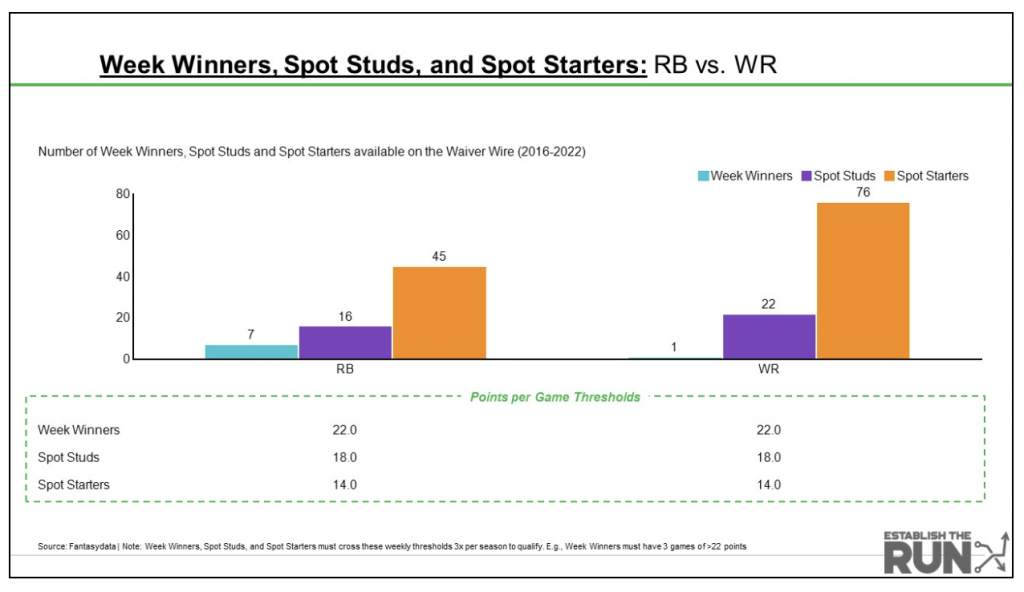
Key Takeaways
- It is easier to find “Week Winners” off the waiver wire at RB vs. WR (reminder: Week winners were undrafted players who had three or more weeks of >22 points). This lines up with our intuition that unheralded RBs can fall into weeks of huge volume due to injury and put up huge scoring weeks for your team off the waiver wire.
- On the other hand, it is easier to find Spot Studs and Spot Starters at WR than RB. In other words, you are more likely to find players that contribute multiple weeks of >18 or >14 points at WR than you are at RB.
- It’s worth noting here that, on a weekly basis, RB scoring is more predictable than WR scoring. Generally, it will be clear when it is a good idea to start a back off the waiver wire (usually, when the starter is injured). At WR, on the other hand, players that consistently run a lot of routes but see few targets can produce “unpredictable” spike weeks (think: Marquez Valdes-Scantling, DeVante Parker, Gabe Davis, etc.). Thus, this analysis may overstate the impact of waiver wire contributors at WR compared to RB, because it will likely be much more challenging to identify the WR spike weeks than the RB spike weeks.
Conclusions & Implications for Waiver Strategy
Let’s summarize the key takeaways and how it can help you approach your draft and waivers from a 10,000-foot view:
- If a RB or WR projects for ~15 points or more per game for the rest of the season, target them aggressively. These players are a rare breed, with only five such RB/WRs meeting this threshold since 2016, meaning you will have very limited chances to add such a player to your roster over the course of the fantasy season.
- Note: If you are not well-versed in projections, don’t worry! At ETR, we’ll help you understand how waiver wire targets project for the rest of the season, and will certainly be talking about them during the weekly waiver wire shows.
- It is easier to find true breakout studs off the waiver wire at RB compared to WR. If you are expecting to find top-12 production at either position, whether it be over the course of the season or for a few-week stretch, it is much more plausible that you will find that at RB vs. WR. Thus, you could argue that if you are looking to maximize upside on your roster, it’s better to leave yourself thin at RB as compared to WR. However, keep in mind that there is not an abundance of RB1s available off the wire. On a season-long basis, there have been just four RB1s available off the wire since 2016, or ~0.5 RB1s per year. So, if you are a zero RB or WR-heavy drafter, keep in mind that it will still be challenging to find true difference-makers off the waiver wire at RB.
- It is easier to find starters and flex-worthy players at WR compared to RB. This one may be slightly counterintuitive, but it is actually fairly plausible to find starters and flex players at WR off the waiver wire. This suggests that carefully mining the waiver wire for WR starters is a great way to build out roster depth when bye weeks and injuries start to stack up.
- RB scoring off the waiver wire is more predictable than WR/TE. This is shown less comprehensively in the data, but it is something most experienced fantasy players recognize. When an NFL team’s RB1 goes down due to injury, their RB2 immediately will project for significant touches and can immediately be slotted into starting lineups. This dynamic is less straightforward at WR/TE, where players have to earn targets from their QBs, and can’t simply have the football handed to them 15-20 times per game. The implication here is that while the data may suggest it is easier to find starters and flex-worthy players at WR compared to RB, in practice it may be more challenging to predict WR scoring on a weekly basis compared to RB.
- Target ambiguous backfields aggressively in Week 1. Myles Gaskin, James Robinson, Jordan Howard, and Chris Thompson all emerged from ambiguous backfields to become low-end fantasy RB1s. All of them clearly had larger roles than expected in Week 1. If a RB flashes a larger-than-expected role in Week 1 and has relatively weak RB competition, be aggressive about snatching them off the wire ASAP.
- Finding starters at TE is easy, but rarely are true difference-makers available. Don’t panic if you finish your draft feeling queasy about your starting TE — you should have plenty of opportunities on the waiver wire to find usable production at the position. However, don’t expect to be able to compete with the Travis Kelce and Mark Andrews teams for TE points. Those teams will likely crush you at the position, but they paid a high cost in the form of a first- or second-round pick to do so. That means you should theoretically have a large advantage over them at another position, making late-TE strategies viable.
- Look for rookie QBs to find ceiling off the waiver wire. As the fantasy market gets better and better at projecting which QBs will lead the league in scoring, it is becoming more difficult to stream high-end QB points off waivers. That said, if a rookie QB flashes early, they may be worth a stash, as they may have untapped upside not reflected by their ADP.
Top Five Waiver Wire Tips for Dominating Your Leagues
Tip 1: Understand the Three Drivers of Fantasy Scoring
Fantasy football is so complicated today. There are seemingly infinite advanced stats, to the point where you can concoct arguments for and against every fantasy-relevant player. It’s easy to talk yourself into circles and wind up confused.
Let’s cut through the noise and talk about what really matters for identifying fantasy scoring off the waiver wire. Ultimately, there are really just three drivers:
- Player talent – how good is Player X?
- Intra-positional group competition – how good are the other players playing the same position on Player X’s team?
- Overall team outlook – how good is Player X’s team? Or more specifically, how good is Player X’s team at producing points at Player X’s position?
Obviously, this framing is a simplification, but it is useful as a screener for analyzing players off the waiver wire. Stated even more simply:
- How good are they? (Ideal Answer: Very good)
- Do they have a lot of competition for touches/playing time? (Ideal Answer: No competition)
- How good is their team for scoring points at their position? (Ideal Answer: Best team in the NFL)
When you’re examining players off the waiver wire and trying to choose amongst them, this framing provides a useful starting point. It can also help you quickly prioritize your list of waiver wire targets. If you view two players as similar talents with similar levels of competition but Player A plays on the worst offense in the NFL and Player B plays on the highest-scoring team, that’s an easy tiebreaker to prioritize Player B.
Tip 2: Increase your Number of At-Bats
Unsurprisingly, the best fantasy managers are the most active on the waiver wire. By constantly churning the end of your roster, you are increasing the number of chances you have to strike gold on the waiver wire.
In practice, this comes in several forms. First, some fantasy platforms (e.g., Yahoo, FFPC) will allow you to cut bench players after their games have finished, provided you don’t put them in your starting lineup. This loophole allows savvy fantasy managers to increase their number of at-bats on the waiver wire in a given week. For example, let’s look toward Thursday Night Football in Week 1, where the Chiefs face off against the Lions. On platforms that allow me to cut bench players, I’m making sure to roster Chiefs backup RBs (Jerick McKinnon and Clyde Edwards-Helaire) going into that TNF matchup. Then, if presumed starter Isiah Pacheco were to suffer an injury, I would have Week 2’s waiver wire cover boy already on my roster.
Another way to increase your number of at-bats is to cut bench players during their BYE weeks. Going back to the Chiefs example, say you are stashing Edwards-Helaire as a handcuff on your bench going into the Chiefs’ BYE in Week 10. Since Isiah Pacheco is also resting that week and has a very minimal chance of getting injured, holding Edwards-Helaire through the BYE is suboptimal. You can increase your number of at-bats by cutting Edwards-Helaire in favor of a different handcuff RB whose team is playing in Week 10 (say, Chuba Hubbard on the Panthers).
In summary, always look for opportunities to gain extra opportunities to strike gold on the waiver wire. Maximize your chances of finding players at the end of your bench that could spike in value the following week.
Tip 3: Evolve from “Best Available” to “Team Needs” as the Season Goes On
In the NFL Draft, GMs broadly have two choices: They can either draft the most talented player on their Big Board, regardless of position, or they can target the player that fills the biggest gap on their roster. These two approaches are known as “Best Available” and “Team Needs”.
When managing the waiver wire in your fantasy league, you are faced with a similar choice. Do I target the position where I am weakest, or do I grab the best player overall, even if I’m stacked at the position he plays?
Early in the season, I lean toward the “Best Available” approach quite heavily, for three reasons. First, I have typically drafted a team that has startable production available at each position, so there are no urgent holes in need of immediate filling. Second, predicting what your “Team Needs” are early in the season is often a fool’s errand. What looks like your strongest position group can quickly be decimated by injury or poor performance, and your weakest position group may consist of breakout stars that will be season-long studs on your roster. Thus, by “knowing what I don’t know”, I look to target the best player available knowing that my “Team Needs” prescription could look silly in a few weeks. Third, targeting the best player available offers you the most liquidity in your league’s trade market. For example, if you had Patrick Mahomes last year and prioritized Justin Fields when he was on waivers, you likely would be able to trade either Mahomes or Fields for a stud RB/WR/TE that would ultimately help you more than whatever RB/WR/TE was available on waivers.
Later in the season, however, I start to shift more toward the “Team Needs” approach for a few reasons. First, injuries and bye weeks often force you to look to the waiver wire to find an immediate starter. In these circumstances, it is often best to prioritize team needs if you need to start that player right away. Second, trading becomes more difficult as the season goes on, either due to league rules or disinterest from your eliminated league-mates. Finally, during the fantasy playoffs, team needs become the end-all-be-all. Except in rare circumstances where you are blocking your opponents from adding a starter to their roster, each of your moves in the playoffs should be laser-focused on your team needs and incrementally improving your starting roster.
Tip 4: Play Fast and Loose with Kicker and D/ST
Kicker and D/ST are historically unpredictable positions with extremely volatile weekly scoring profiles. Don’t become emotionally attached to them. Churn them ruthlessly on the waiver wire in search of better matchups. Unless you have an extremely deep bench, definitely cut them during their bye weeks to get more at-bats at other positions. You can even selectively choose kickers and D/STs on Monday Night Football, and then if it’s clear their score won’t affect whether you win or lose, you can cut them for a handcuff RB or potential breakout WR that’s playing in the game.
Never roster more than one kicker at a time. You should very rarely roster more than one D/ST at a time, which leads to my next tip…
Tip 5: Be Ready to Shift to Playoff Mode
Though we touched on it a bit with Tip 3, I can really not overstate the differences in my waiver wire approach early in the regular season compared to the playoffs. They are almost entirely different. Here are a few areas where waivers in the playoffs are entirely different:
-
- Block your opponents – During the regular season, I almost never look at my opponents’ rosters to block them from adding players of need. In the playoffs, I become obsessive about this. If my opponent’s starting QB got injured and there is a clear best QB available on the waiver wire, I’m making sure to prioritize adding that QB to block them. Does my opponent desperately need RB points? I’m aggressively targeting all the RBs with sizable projections on the waiver wire. Be an asshole and block your opponents.
- Note: If you are playing in a FAAB league, I am purposefully looking to save some of my budget for the playoffs for this purpose. Being able to outbid your opponent in the fantasy championship for their position of need is a huge advantage in the week that matters most.
- Block your opponents – During the regular season, I almost never look at my opponents’ rosters to block them from adding players of need. In the playoffs, I become obsessive about this. If my opponent’s starting QB got injured and there is a clear best QB available on the waiver wire, I’m making sure to prioritize adding that QB to block them. Does my opponent desperately need RB points? I’m aggressively targeting all the RBs with sizable projections on the waiver wire. Be an asshole and block your opponents.
- Roster multiple defenses if matchups dictate – Defensive scoring in fantasy is highly dependent on the matchup. In the playoffs, I’m often cutting that WR6 or WR7 that I’m very unlikely to start in favor of a second defense that has a great upcoming matchup. Oftentimes, your opponents will fail to look one week ahead, so in Week 16, you can grab the D/ST that’s playing the journeyman third-string QB in Week 17 for your fantasy championship
- Team Needs > Best Available – This was already covered in Tip 3, but I’m highlighting it again here as a reminder that Team Needs far and away trump Best Available on the waiver wire in the fantasy playoffs
Bonus Tip 6: Read My Article and Watch My YouTube Show! Every Week!
…unless you are playing against me in any leagues. Then you are legally not allowed to read my content (yes, Xander, I’m talking to you).
But seriously! I’ll be working at Establish The Run this NFL season with waivers as my main focus, so I will be 100% dialed in. Furthermore, I have thousands of United States dollars at stake across my various managed leagues, so I have skin in the game. The advice I will give you corresponds directly to how I will make waiver claims in my own leagues.
In conclusion, I hope you found this helpful. Best of luck with your remaining drafts before the NFL season. I look forward to joining you on your waiver wire journey this fantasy football season.


